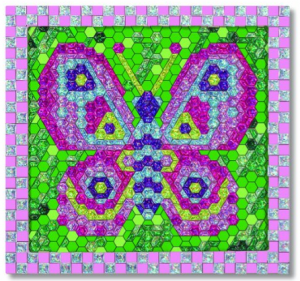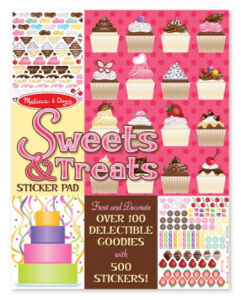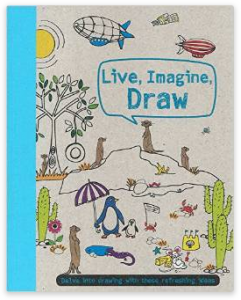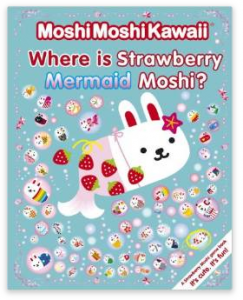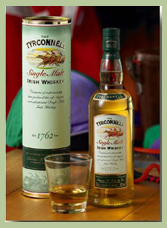Rbelle writes:
I’m wondering if you would be willing to do a post about your family journal and how it works – i.e., what types of things you put in it, how often you update it, how long do you spend? I’m feeling terrible that I have so little record of my oldest’s life so far (she’s almost four), but I gave up keeping a journal for myself when I realized it was all FEELINGS and no one but me would care about my FEELINGS years from now, but I didn’t want my FEELINGS ending up in a landfill for the hyper-evolved rats to read, either. On the flip side, my mom keeps a diary of every day that is literally just “we did x, went y, and ate z,” and that just seems tedious and time-consuming. I’m looking for a middle ground, and a “family journal” sounds very intriguing.
The journal system I use is one that happened after I tried a bunch of other ways (3-ring binder, small diaries with lined pages, regular notebooks, baby books) and didn’t like them and/or liked them for awhile but then didn’t want to do it that way anymore. I use Canson 9×12 recycled field sketch books: cardboard-bound spiral books of unlined paper, which I found in a stationery store back where I used to live; when I moved, I couldn’t find them ANYWHERE and my friend Surely went to the stationery store for me, placed a huge order for me, and then boxed them all up and shipped them to me. I’m still taking journals from that supply, well over a decade later. They were something like $10 each when I bought them; I see Amazon is selling them for $25 now. I can’t picture paying $25, so when I run out of my stash I’ll have to see what’s available. (Or I see I can get them here for $13.40 each if I buy in sets of six, so that’s probably what I’ll do; that seems like a reasonable price increase after fifteen years.)
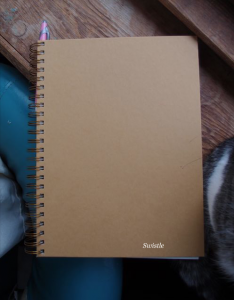
When I finish a journal, I write the date and age range on the front cover in black permanent marker; for example:
April 12, 2008 – July 16, 2009
Robert: 9 years 3 months – 10 years 6 months
William: 7 years 0 months – 8 years 4 months
Elizabeth and Edward: 2 years 10 months – 4 years 1 month
Henry: 10 months – 2 years 1 month
I’d say I needed three main concepts in order to make this system work for me. The first main concept: “Doing it the way I like doing it, even if that changes.” For a lonnnnng time, I glued photos on the left-hand side of the page, but I think it was after the twins were born that I lost the oomph for doing that (and mostly stopped getting photos printed), and it was CRUCIAL to be able to say, “Then I’m not going to do that anymore, even though it means the journals are not consistent.” Ditto for when I used to WRITE on the left-hand side: I didn’t like the way the spiral dug into my hand/wrist/arm, and so after awhile I stopped that and only wrote on the right-hand side. It was CRUCIAL to be able to say, “If I don’t like it, I’m not going to do it anymore, even though it means (1) the journals are not consistent and (2) I’m kind of wasting paper.”
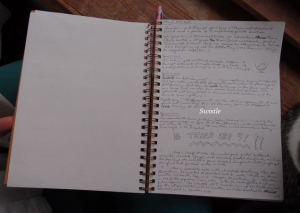
The second main concept is “not worrying about it too much.” If I scribble something out, if I forget to write something down, if I have to write, “Oh, I forgot to say that last week we…,” if my handwriting is messy, if I keep track of something for one kid that I didn’t think to keep track of for another kid—none of that really matters.
And the third crucial concept was the English-class one of “choosing the audience.” My guess is that my children are extremely unlikely to want to read detailed smooshy “Today you are twenty-seven months old and you are the heart outside Mommy’s body” stuff, either as children or later as adults; I came to that theory by imagining my own mother writing such things and asking myself if I’d be interested in it (“No”). The intended audience of my journal, then, is Later Me. I can picture myself paging through to remember these years, and so I write what I think I will be interested in, and I write it to myself: “William likes peas and oatmeal,” not “You like peas and oatmeal.”
However, I realize I’m only guessing about my children’s future interest, so I keep that in mind as well: I don’t write it down every time I wonder if I would have been happier not having children, for example. I DO, however, write about somewhat personal things like weaning hormones, or when I’m frustrated about discipline issues, or at what point my periods started up again after childbirth, or how unhappy I was when Paul and I disagreed about how many children to have, or how miserable I found pregnancy. And I write about various things I suppose could hurt their feelings but could also help them when they have children of their own, or could help them understand their own childhoods: I write about my temper, and I write about how frustrating the children can be, and I give examples. I don’t want them (or me) remembering that I yelled for no reason. I also deliberately write things now and then about how delightful and fun I find them, though I hope the very existence of these journals also communicates that.
Here are some of the other things I put into the journals:
1. Milestones such as first steps, first teeth, first foods, lost teeth, getting glasses.
2. What they got for their birthdays or Christmas.
3. Funny things they say.
4. Their hobbies and interests (“Elizabeth started karate”; “William has been very interested in codes”).
5. Stuff we do, if it’s not what we typically do (“Today we went on a hike to _____”).
6. Stuff we do, if it’s what we typically do and I am in the mood to write down a snapshot of it to give me an idea later on of what life was like at the time (“Usually we get up at ____ o’clock; this is what they eat for breakfast; this is who has to be nagged to get ready for school; after school, we ___; while they’re gone, I _____,” etc.
7. Examples of their bad behavior.
8. Our baby-name-choosing lists, with the rejected ones crossed out so that they can still be read.
When they were younger, I wrote a LOT more. Little kids generate a lot more milestones and cute anecdotes than teenagers do. And there is so much more to SAY about little kids, though time has shown that I am not very much interested later on in lists of all the foods they ate, every word they could say, or what sizes they were wearing. (I did find those lists useful when siblings were at those ages: for example, it was useful to be able to find out when I started the baby on what foods the last time, or to reassure myself that no, this baby is NOT way behind his siblings in language development.)
What I MOST value later on are the anecdotes about funny things they said, the reports of their bad behavior, and the periodic descriptions of what life was like at that time. When they were younger I tried very hard to be REGULAR about the life-descriptions, doing one every month. That got overwhelming, so I stopped—and I’m glad I did, because the regimented/detailed (I had categories such as Eating, Sleeping, Playing, Talking) monthly reports are…quite dull. And monthly is wayyyyyyy too often. But if I do one every year or two, and I just write whatever comes to mind instead of following set categories, I find I really enjoy those later. It’s interesting how quickly I forget what used to be completely routine (“Then one of us sits with Elizabeth until she falls asleep…”).
I also do like the milestone stuff: many times I’ve been glad to be able to say when someone did/got/started this or that: I’d think I’d remember, but I really don’t. But I don’t worry about it if I forget to mention every lost tooth and every new extracurricular activity.
I’ve used the gift reports as a way to remember what the kids liked at certain ages. So if for example I need to buy a gift for a 2-year-old, I’ve LONG forgotten what 2-year-olds like—but I can look back at what I bought my own kids at that age and get some good ideas.
The basic idea is that it’s a jumble, and I don’t try too hard to be consistent. If I think I have to write every day, or record every single funny anecdote, or write a 2-page report every month, I get overwhelmed and stop wanting to do it. Instead I keep the journal very handy (next to my favorite chair), and I write on no particular schedule, and I try to avoid getting regimented/obsessive/weird about it. I’d rather have one anecdote out of a hundred than ZERO anecdotes out of a hundred—and if I end up with THREE anecdotes out of a hundred, how VERY NICE.
I think that when the system is all written out like this it can look overwhelming, too. I remember when for English class we had to write detailed instructions about how to make a peanut butter and jelly sandwich, and WOW that looks like a lot of time and fussy work! And yet it isn’t: you just make the sandwich and it only takes a couple minutes. Also, I think it can look overwhelming to read someone else’s system, because what’s natural/comfortable for me might not be natural/comfortable for you: perhaps what will work for you is typing your journal in a wordprocessing document and getting in the habit of working on it for 5 minutes per day before bed. Or perhaps what will work for you is buying a different pretty journal for each child and jotting down mostly milestones and the occasional anecdote. Or perhaps you’ll want to use a 3-ring binder so it’s easier to remove/rearrange pages. Whatever works best for you is what you’re most likely to find easy and non-overwhelming.


